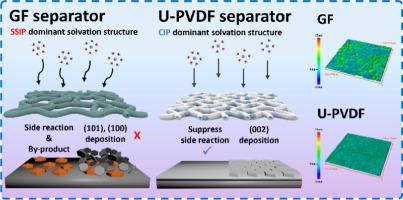In situ directly grown carboxylated UiO-66-infused separator as a comprehensive regulator of Zn solvation structure enabling dendrite- and corrosion-free Zn metal anode
IF 14.9
1区 化学
Q1 Energy
引用次数: 0
Abstract
Aqueous zinc ion batteries (AZIBs) are considered promising candidates owing to their inherent safety and low cost. However, the conventional glass fiber (GF) separator used in AZIBs suffers from poor physicochemical properties, leading to uncontrolled zinc (Zn) dendrite formation and undesirable side reactions. To address these limitations and enhance the electrochemical performance of AZIBs, a precisely designed functional separator is developed by incorporating UiO-66-(COOH)2 into a poly(vinylidene fluoride) (PVDF) framework (U-PVDF) via a direct in situ growth method. This approach enables uniform distribution of UiO-66-(COOH)2 both on the surface and within the PVDF backbone, without increasing separator thickness. Owing to the strong interaction between Zn2+ and the abundant carboxyl groups in UiO-66-(COOH)2, the U-PVDF separator regulates the Zn2+ solvation structure toward a contact ion pair-dominated structure by reducing coordinated water molecules, which effectively mitigates water-induced parasitic reactions and promotes compact Zn deposition. Consequently, a Zn/Zn symmetric cell employing the U-PVDF separator demonstrates superior cycling stability over 1500 cycles without internal short-circuiting at a current density of 6 mA cm−2 and an areal capacity of 2 mAh cm−2. Moreover, Zn/NaV3O8·xH2O (NVO) cell with the U-PVDF separator exhibits markedly improved cyclability and rate performance compared with those using conventional GF separator.

原位直接生长的羧化uio -66注入分离器作为锌溶剂化结构的综合调节剂,实现了无枝晶和无腐蚀的锌金属阳极
水锌离子电池(azib)由于其固有的安全性和低成本而被认为是有前途的候选者。然而,用于azib的传统玻璃纤维(GF)分离器的物理化学性能较差,导致锌枝晶形成不受控制和不良的副反应。为了解决这些限制并提高AZIBs的电化学性能,通过直接原位生长方法将UiO-66-(COOH)2加入聚偏氟乙烯(PVDF)框架(U-PVDF)中,开发了一种精确设计的功能分离器。这种方法可以使UiO-66-(COOH)2在PVDF骨架表面和内部均匀分布,而不增加分离器的厚度。由于Zn2+与UiO-66-(COOH)2中丰富的羧基之间的强相互作用,U-PVDF分离器通过减少配位水分子,将Zn2+的溶剂化结构调节为接触离子对主导结构,有效地减轻了水诱导的寄生反应,促进了Zn的致密沉积。因此,采用U-PVDF分离器的Zn/Zn对称电池在电流密度为6 mA cm - 2和面积容量为2 mAh cm - 2的情况下,在1500次循环中表现出优异的循环稳定性,没有内部短路。此外,与使用常规GF分离器相比,使用U-PVDF分离器的Zn/NaV3O8·xH2O (NVO)电池具有明显改善的循环性能和倍率性能。
本文章由计算机程序翻译,如有差异,请以英文原文为准。
求助全文
约1分钟内获得全文
求助全文
来源期刊

Journal of Energy Chemistry
CHEMISTRY, APPLIED-CHEMISTRY, PHYSICAL
CiteScore
19.10
自引率
8.40%
发文量
3631
审稿时长
15 days
期刊介绍:
The Journal of Energy Chemistry, the official publication of Science Press and the Dalian Institute of Chemical Physics, Chinese Academy of Sciences, serves as a platform for reporting creative research and innovative applications in energy chemistry. It mainly reports on creative researches and innovative applications of chemical conversions of fossil energy, carbon dioxide, electrochemical energy and hydrogen energy, as well as the conversions of biomass and solar energy related with chemical issues to promote academic exchanges in the field of energy chemistry and to accelerate the exploration, research and development of energy science and technologies.
This journal focuses on original research papers covering various topics within energy chemistry worldwide, including:
Optimized utilization of fossil energy
Hydrogen energy
Conversion and storage of electrochemical energy
Capture, storage, and chemical conversion of carbon dioxide
Materials and nanotechnologies for energy conversion and storage
Chemistry in biomass conversion
Chemistry in the utilization of solar energy
 求助内容:
求助内容: 应助结果提醒方式:
应助结果提醒方式:


